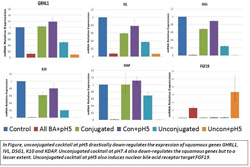|
|
Back to 2014 Annual Meeting Abstracts Unconjugated but Not Conjugated Bile Acid Reduces Squamous Differentiation in Esophageal Cells Possibly Through Intracellular Mechanisms Sayak Ghatak*1, Liana Toia2, Eileen Redmond2, Tony E. Godfrey3, Jeffrey H. Peters2 1Biology, University of Rochester, Rochester, NY; 2Surgery, University of Rochester Medical Center, Rochester, NY; 3Surgery, Boston University, Boston, MA
Background: Barrett's Esophagus (BE) is a precancerous lesion in which the normal squamous epithelium of the esophagus undergoes columnar metaplasia as a result of protracted duodeno-esophageal reflux. Bile acid (BA) both conjugated and unconjugated at an acidic pH, forms the chief component of reflux and has the ability to affect cellular processes by virtue of its anionic detergent action or acting as a signaling molecule. Previously, our group had shown that the esophageal squamous epithelium loses the expression of genes involved in squamous differentiation following exposure to a cocktail containing conjugated and unconjugated BA at pH5. In this study, we aimed determining which BA component, whether conjugated or unconjugated, predominantly contributed to the down-regulation of squamous differentiation. Back to 2014 Annual Meeting Abstracts |
||||||||||
© 2025 Society for Surgery of the Alimentary Tract. All Rights Reserved. Read the Privacy Policy.


